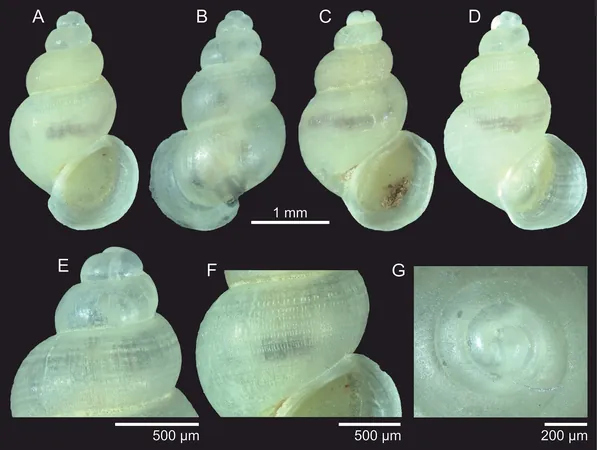
Unveiling the Hidden Costs: How Bacillus thuringiensis Affects Aedes albopictus Mosquitoes
2024-11-07
Author: Charlotte
Introduction
In a startling revelation, researchers highlighted the often-overlooked implications of Bacillus thuringiensis (Bti) use on the notorious Aedes albopictus mosquito, a significant vector for diseases such as dengue and chikungunya. With vector-borne diseases causing over 700,000 deaths globally each year, understanding our battle against these pests has never been more critical.
The Challenge of Vector Management
As the prevalence and geographic reach of these viral threats have exponentially risen over the past five decades, traditional control methods are increasingly challenged. While vaccines and therapeutic options are scarce, vector management through environmentally friendly products like Bti remains a crucial line of defense. Bti's potency lies in its parasporal crystals, which contain four major protoxins known to decimate mosquito larvae.
Emergence of Tolerant Larvae
However, amidst the battle against these disease carriers, a surprising wrinkle emerges. Continuous use of Bti exerts pressure on mosquito populations, leading to the emergence of 'tolerant' larvae—those who survive lethal doses of this otherwise lethal bacterial formulation. The pressing question remains: do these tolerant survivors suffer long-term repercussions as they mature into adults?
Research Findings on Fitness and Gut Microbiota
Recent investigations explored this very topic by assessing the fitness and gut microbiota changes in both tolerant larvae and their adult descendants after exposure to Bti. What researchers found was unexpected: the toll on adult mosquitoes originating from these C73 Bti-tolerant larvae was significant, leading to reduced emergence rates, shorter lifespans, and lower levels of fecundity, even if the next generation showed no apparent effects.
Microbial Community Changes
Studies on the gut microbiota revealed a remarkable shift in the microbial community composition among exposed larvae and their adult counterparts. The analysis carried out using advanced 16S sequencing techniques unveiled a correlation between Bti exposure and increased diversity within the gut’s microbial population. Notably, the composition significantly differed from non-exposed counterparts, suggesting that Bti did not just eliminate larvae but significantly reshaped their biological ecosystems.
Immune Response and Evolutionary Implications
Immune responses were also activated in these mosquitoes, with higher expression levels of specific immune genes in tolerant larvae, suggesting an evolutionary arms race could be underway between the bacteria and these resilient insects. This immune response, while aiding in survival post-Bti exposure, could potentially render these mosquitoes more susceptible to viral infections, raising concerns about their vectorial capacity.
Implications for Future Vector Management
Interestingly, the research highlighted that even though the adult mosquitoes stemming from tolerant larvae exhibited diminished fitness in terms of survival and reproductive success, these effects didn't translate to the subsequent generation. This observation indicates a fascinating but complex interaction between Bti exposure, immunity, and gut microbiota, hinting that adaptations may not solely rely on visible traits but also on a deeper biological interplay.
As the ongoing fight against vector-borne diseases continues, these findings underline the importance of holistic approaches. Effective vector management must balance the use of products like Bti with awareness of their long-term implications on insect populations. This intricate tapestry of ecological interactions signals a call for more comprehensive studies, paving the way for innovative solutions in public health.
Conclusion
In conclusion, while Bti remains an effective tool against Aedes mosquitoes, the emergence of tolerance highlights that we must keenly monitor both the intended and unintended consequences of our interventions. The complex interactions of immunity, gut microbiome, and fitness are vital in our quest for victory over these disease-spreading foes. Will we learn from nature's lessons, or continue to play catch-up in this evolutionary game of survival? Only time will tell.









 Brasil (PT)
Brasil (PT)
 Canada (EN)
Canada (EN)
 Chile (ES)
Chile (ES)
 España (ES)
España (ES)
 France (FR)
France (FR)
 Hong Kong (EN)
Hong Kong (EN)
 Italia (IT)
Italia (IT)
 日本 (JA)
日本 (JA)
 Magyarország (HU)
Magyarország (HU)
 Norge (NO)
Norge (NO)
 Polska (PL)
Polska (PL)
 Schweiz (DE)
Schweiz (DE)
 Singapore (EN)
Singapore (EN)
 Sverige (SV)
Sverige (SV)
 Suomi (FI)
Suomi (FI)
 Türkiye (TR)
Türkiye (TR)